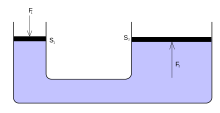
Back طاقة السوائل Arabic Snaga fluida BS توان سیال Persian Hydromécanique French Tenaga fluida ID Fuqia e lëngut Albanian Kusog han Pluwido WAR 流體動力 Chinese

Fluid power is the use of fluids under pressure to generate, control, and transmit power. Fluid power is conventionally subdivided into hydraulics (using a liquid such as mineral oil or water) and pneumatics (using a gas such as compressed air or other gases). Although steam is also a fluid, steam power is usually classified separately from fluid power (implying hydraulics or pneumatics). Compressed-air and water-pressure systems were once used to transmit power from a central source to industrial users over extended geographic areas; fluid power systems today are usually within a single building or mobile machine.
Fluid power systems perform work by a pressurized fluid bearing directly on a piston in a cylinder or in a fluid motor. A fluid cylinder produces a force resulting in linear motion, whereas a fluid motor produces torque resulting in rotary motion. Within a fluid power system, cylinders and motors (also called actuators) do the desired work. Control components such as valves regulate the system.
© MMXXIII Rich X Search. We shall prevail. All rights reserved. Rich X Search